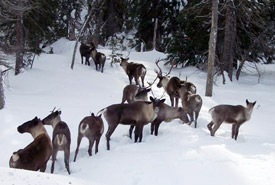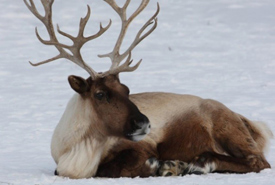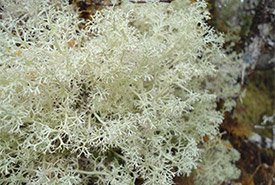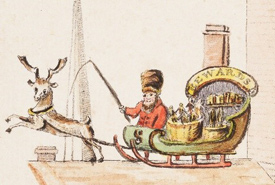Santa's large helpers

Caribou on Darkwoods, British Columbia (Photo by Christian Schadendorf)
"Now, Dasher! Now, Dancer! Now, Prancer and Vixen!
"On, Comet! On, Cupid! On, Dunder and Blixem!"
Santa’s reindeer are kind of a big deal. They have important jobs, as they’re pretty much celebrities in the North Pole. Read on to find out six things you probably didn’t know about reindeer.
The names caribou and reindeer are interchangeable. Both are common names for the Rangifer tarandus species, but the different names are based on location. In Canada and Alaska, we call them caribou, but in Europe and Asia, they are called reindeer. In addition, there are many subspecies based on different morphologies and behaviours. To make this matter less complicated, in Canada, caribou can be grouped into three habitat regions: those that live in the boreal forest, the continental tundra and the high Arctic islands.

Reindeer (Photo by Brent Huffman)
Reindeer are very well adapted to freezing temperatures. They have two layers of hair all over their body. The first layer, or undercoat, is made up of soft, woolly hairs while the second layer is comprised of long, hollow hairs called guard hairs. Air molecules enter the guard hairs and are warmed by the reindeer’s body heat. The air molecules become trapped there, forming an insulating layer to keep the reindeer nice and toasty.
Reindeer are one of the only mammals that can digest lichens. This is thanks to a special enzyme called lichenase in their gut. What’s so tough about lichens? Lichens are actually a symbiose between a fungus and an alga species, which means they aren’t plants. Their composition is too complex for the typical herbivore stomach, but not for reindeer.

Reindeer lichen (Photo by Mac Pitcher)
Reindeer have magical eyes. Okay, maybe not magical, but reindeer’s eyes change colour depending on the season. This is an adaptation to the drastic changes in daylight seen in the Arctic. Reindeer are the only mammals known to that have this adaptation. What’s the secret? A reindeer’s retina, which contains light-sensitive cells that reflect light that enters the eye, is highly specialized. The reflected light produces either a golden colour in the summer or a blue colour in the winter.
The first reference of Santa Claus and his reindeer was in 1821. Old Santeclaus with Much Delight by an anonymous author includes one of the earliest illustrations of the Santa Claus figure with his sleigh and reindeer. Two years later, in 1823, A Visit from St. Nicholas, more commonly known as The Night Before Christmas, was published. This poem introduced the world to a miniature sleigh and eight tiny reindeer. Scholars believe that the tiny reindeer in the poem refer to the smallest subspecies of reindeer, called the Svalbard. They live on the Arctic islands past Norway and are roughly 30 per cent smaller than the average reindeer.

Santa Claus and his reindeer (Photo by Beinecke Digital Collections, Yale)
Santa’s reindeer are all female. Unlike other deer species, both male and female reindeer have antlers, though up to half of females may lack antlers or have just one antler. Male and female reindeer grow, shed and drop their antlers at different times. Males begin to grow their antlers around February, shed the velvet tissue covering their antlers during summer and drop their antlers between November and early December. Females, on the other hand, grow their antlers in spring, shed their velvet tissue later in spring around calving time and don’t drop their antlers until after winter.
“He sprang to his sleigh, to his team gave a whistle,
And away they all flew like the down of a thistle.
But I heard him exclaim, ere he drove out of sight,
Happy Christmas to all, and to all a good night!”
Song lyrics source: https://www.lyricsondemand.com/christmascarols/t/twasthenightbeforechristmaslyrics.html


